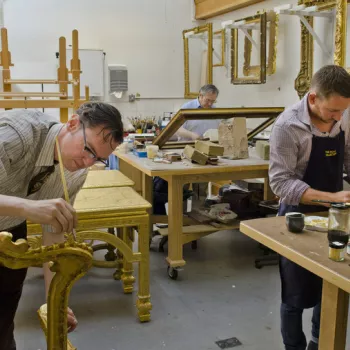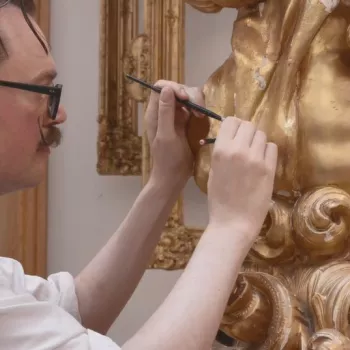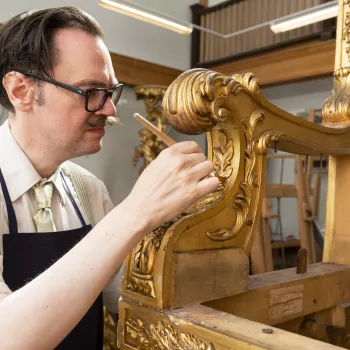Gilding

Gilding refers to the process of applying extremely thin sheets of gold, called gold leaf, to a surface.
Most gilded furniture and frames are made of wood that has been covered in gesso; a plaster-like material made of chalk and glue that is painted on hot, with a brush. It can be applied very thinly over detailed carving, or it can be built up with many layers into a thickness which can itself be carved; this is called 'cut gesso'.
Water Gilding
In water gilding, the first layer applied to the gesso is usually a semi-transparent mixture of yellow ochre pigment and glue. This partially seals the gesso, and also gives some colour to the gesso which can help disguise any deep recesses where the gold might not reach. The next layer is called bole, or clay. This is a very fine clay with a rich colour, mixed with water and a very small amount of glue. The bole provides a rich backing colour for the gold, which is so thin that it takes on qualities of the colour of the bole beneath. Colours of bole varied according to fashion.
The use of bole also allows for a special quality of water gilding: the ability to burnish. The bole underneath the gold is slightly compressible, or springy. By applying an agate stone, the gold leaf is burnished, or brightly polished, making a smooth and highly reflective surface. Water gilt furniture and frames take advantage of this effect and feature a dramatic contrast between burnished and matte areas. This effect would have been especially pronounced when rooms were lit with candles.
Oil Gilding
When furniture and frames are oil gilded, the first layer is also gesso applied to the wood. This was then usually sealed with a strong layer of glue, and then an oil size (a linseed oil based varnish). Sometimes a coloured size was used; usually a rich ochre colour. Modern size is now more often clear, and a coloured layer is applied first. In both cases, the colour provides a warm backing colour for the gold, and helps to disguise any tiny holes in the gilding. The oil size is applied thinly and evenly, and when it is nearly dry gold leaf is applied. Wherever the size is applied, the gold leaf will stick. Oil gilding cannot be burnished, but there are other advantages: the gold can be made to stick over more complicated surfaces with deeper recesses than in water gilding. It is also much more durable, and can even be used outside on metal and stone. Most architectural gilding, indoors and out, has been oil gilded.










